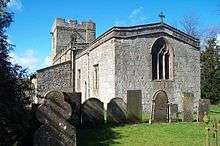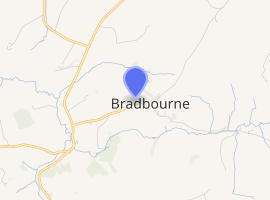All Saints' Church, Bradbourne
All Saints’ Church, Bradbourne is a Grade I listed parish church in the Church of England[3]:103 in Bradbourne, Derbyshire.
| All Saints’ Church, Bradbourne | |
|---|---|
 All Saints’ Church, Bradbourne | |

| |
| 53°04′16.08″N 1°41′27.65″W | |
| Location | Bradbourne, Derbyshire |
| Country | England |
| Denomination | Church of England |
| History | |
| Dedication | All Saints |
| Architecture | |
| Heritage designation | Grade I listed[1] |
| Administration | |
| Parish | Bradborne |
| Deanery | Wirksworth[2] |
| Archdeaconry | Chesterfield |
| Episcopal area | Derby |
| Diocese | Derby |
| Province | Canterbury |
History
All Saints’ Church was adopted as the village church after the dissolution of the monasteries. It was formerly Bradbourne Priory.
By 1627 the church at Bradbourne was in need of serious repairs, with a greatly decayed roof and decaying timbers, lead, windows and bells, all estimated as costing around £46 (equivalent to £9,057 in 2019)[4] to repair or replace (almost 3 years' average craftsman's wages[5]). On 10 February 1629, Thomas Buxton and Vincent Sexton, churchwardens of Bradbourne, took a suit to the Chancery against William Cokayne, Valentine Jackson and four others living at the nearby village of Atlow, declaring it an ancient custom for all the parishioners of Atlow to pay for the repair of the parish church at Bradbourne, but that they had not been paying it. The following year the court decided that the inhabitants of Atlow were to pay annually 5s. 6d. per oxgang (15 acres) to Bradbourne for repairs; but they were not to be charged for any previous arrears.[6]
In the restoration of 1876–77[7] the nave wall on the north side was in danger of falling outwards and it was repaired largely with Bath stone. A new organ chamber was built out. The chancel was re-fitted and furnished with a stone reredos, inlaid with encaustic slabs with scriptural scenes. The chancel floor was re-laid with Minton tiles. Jones and Willis of Birmingham supplied the lectern, lamp-standards and altar cloths. The alterations were overseen by the architect, Robinson of Derby.
The church was restored in 1906–09. The south aisle, chancel and parts of the tower were underpinned. the aisle walls and gable of the porch was rebuilt. A new oak roof covered with lead was placed on the south aisle, and a new roof on the porch was covered with slates. A new pulpit was presented, and the sanctuary was paved with Hopton stone and Derbyshire marble from the Ashford Dale Quarry which was opened especially for this work. The cost of the restoration amounted to £1,100 (equivalent to £115,508 in 2019)[4] and was supervised by the architects Naylor and Sale of Derby.[8]
Parish status
The church is in a joint parish with
- All Saints' Church, Alderwasley
- St James the Apostle's Church, Bonsall
- All Saints’ Church, Ballidon
- St James’ Church, Brassington
- St Margaret's Church, Carsington
- All Saints’ Church, Elton
- St James’ Church, Idridgehay
- Holy Trinity Church, Kirk Ireton
- Holy Trinity Church, Middleton-by-Wirksworth
- St Mary's Church, Wirksworth
Organ
An organ was obtained in 1866 by Rushworth of Liverpool and installed under the tower arch. It had 5 stops on the manual compass (Open Diapason, Dulciana, Stopped diapason, Principal, Wald Flute) and a 20 note pedal board with a Double-stopped diapason.[9] In 1877 this organ was moved into a new organ chamber. This Rushworth instrument was replaced by an organ installed by Albert Keates of Sheffield at a cost of £300 (equivalent to £33,519 in 2019)[4] in 1893.[10] A specification of the organ can be found on the National Pipe Organ Register.[11]
Bells
The church tower contains a ring of six bells. The treble and 2nd date from 1896, the 3rd and 4th of 1863, all by John Taylor of Loughborough. The 5th and tenor date from 1708 and are by Danuel Hedderly[12]
References
- Historic England, "Church of All Saints (1109479)", National Heritage List for England, retrieved 22 January 2017
- "The Church of St. Mary the Virgin, Bolton-by-Derby". A Church Near You. The Church of England. Retrieved 21 January 2017.
- Pevsner, Nikolaus; Williamson, Elizabeth (1979). The Buildings of England. Derbyshire. Penguin Books Limited. ISBN 0140710086.
- UK Retail Price Index inflation figures are based on data from Clark, Gregory (2017). "The Annual RPI and Average Earnings for Britain, 1209 to Present (New Series)". MeasuringWorth. Retrieved 2 February 2020.
- "National Archives Old Currency Converter". Retrieved 6 April 2013.
- Cox, J (1875). Churches of Derbyshire: Bradbourne:. Retrieved 6 April 2013.
- "Bradbourn. Re-opening of the church". Derby Mercury. England. 30 May 1877. Retrieved 22 January 2017 – via British Newspaper Archive.
- "The Restoration of Bradbourne Church". Derby Daily Telegraph. England. 5 March 1909. Retrieved 22 January 2017 – via British Newspaper Archive.
- "Opening of a New Organ at Bradbourn Church". Derbyshire Advertiser and Journal. England. 14 September 1866. Retrieved 22 January 2017 – via British Newspaper Archive.
- "Opening of the New Organ at Bradbourne Church". Derbyshire Advertiser and Journal. England. 19 May 1893. Retrieved 22 January 2017 – via British Newspaper Archive.
- "NPOR N00412". National Pipe Organ Register. British Institute of Organ Studies. Retrieved 22 January 2017.
- "Bradbourne, Derbys All Saints". Dove's Guide for Church Bell Ringers. Dovemaster. 6 March 2010. Retrieved 21 January 2017.